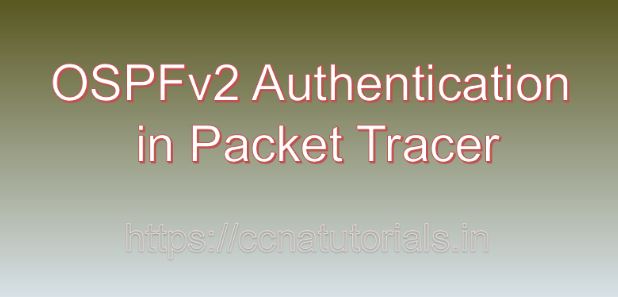Contents of this article
In this article, I describe the process of OSPFv2 Authentication in Packet Tracer. Open Shortest Path First version 2 (OSPFv2) is a widely used routing protocol in computer networks. It enables routers to dynamically exchange routing information, facilitating efficient communication within networks. However, in today’s interconnected world, security is paramount. To enhance the security of OSPFv2 routing exchanges, authentication mechanisms are employed. In this guide, we delve into the intricacies of configuring OSPFv2 authentication in Packet Tracer, a simulation tool widely used for network design and education.
Understanding OSPFv2 Authentication:
OSPFv2 authentication provides a means to verify the authenticity of routing information exchanged between OSPFv2 routers. By implementing authentication, network administrators can mitigate risks associated with unauthorized access and malicious activities within the network. OSPFv2 supports several authentication methods, including plaintext authentication and MD5 authentication.
Configuration OSPFv2 Authentication in Packet Tracer:
- Network Topology Design:
Begin by designing a network topology in Packet Tracer. Ensure that OSPFv2-enabled routers are appropriately interconnected. The network topology should reflect the actual network environment where OSPFv2 authentication will be implemented. - Router Configuration:
Access the command-line interface (CLI) of each OSPFv2-enabled router in Packet Tracer. Enter privileged EXEC mode by typingenableand providing the privileged EXEC password if configured. - Enabling OSPFv2:
Configure OSPFv2 on each router using therouter ospfcommand followed by the OSPF process ID. Specify the OSPFv2 routing process and the router’s OSPF router ID using therouter-idcommand. - Configuring OSPFv2 Authentication:
Decide on the authentication method to be used, whether plaintext or MD5. For plaintext authentication, use theip ospf authenticationcommand followed by the OSPF area number and the authentication key. For MD5 authentication, employ theip ospf authentication-keycommand followed by the authentication key and the OSPF area number. - Assigning Authentication to Interfaces:
Associate authentication with OSPFv2-enabled interfaces using theip ospf authenticationcommand followed by the desired authentication method (plaintext or MD5). Ensure that authentication is applied consistently across all OSPFv2-enabled interfaces within the same OSPF area. - Verifying OSPFv2 Configuration:
Verify OSPFv2 authentication configuration using theshow ip ospf interfacecommand to display OSPFv2 interface parameters. Verify that authentication is enabled and correctly configured on OSPFv2-enabled interfaces. - Testing OSPFv2 Authentication:
Test OSPFv2 authentication by attempting to establish OSPF neighbor relationships between routers. Use theshow ip ospf neighborcommand to verify OSPFv2 neighbor adjacencies. Ensure that OSPFv2 neighbors are authenticated successfully.
Conclusion for OSPFv2 Authentication in Packet Tracer:
In conclusion, implementing OSPFv2 authentication is crucial for securing OSPFv2 routing exchanges within computer networks. By configuring authentication mechanisms such as plaintext or MD5 authentication, network administrators can enhance network security and mitigate potential security threats. In Packet Tracer, a popular network simulation tool, configuring OSPFv2 authentication involves a series of steps, including enabling OSPFv2, configuring authentication keys, and associating authentication with OSPFv2-enabled interfaces.
Through meticulous configuration and testing, network administrators can ensure the robustness and integrity of OSPFv2 routing exchanges in their networks. Mastering OSPFv2 authentication in Packet Tracer empowers network professionals to build secure and resilient network infrastructures capable of meeting the demands of modern networking environments. I hope you found this article helpful related to OSPFv2 Authentication in Packet Tracer. You may drop a comment below or contact us for any queries of suggestions about the contents of this website.






